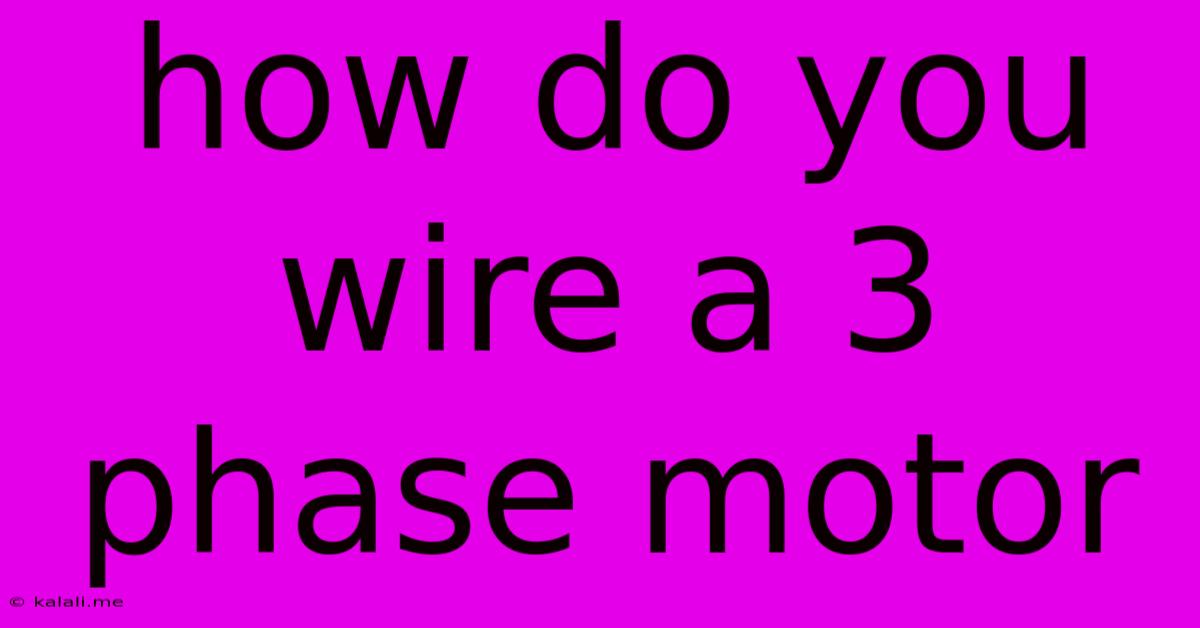How Do You Wire A 3 Phase Motor
Kalali
Jun 05, 2025 · 4 min read

Table of Contents
How to Wire a Three-Phase Motor: A Comprehensive Guide
Wiring a three-phase motor might seem daunting, but with a clear understanding of the process and safety precautions, it's a manageable task. This guide provides a step-by-step walkthrough, covering safety measures, identifying motor components, and completing the wiring process. This article will help you understand the different wiring diagrams and how to choose the correct one for your specific motor. Remember, incorrect wiring can lead to motor damage or even injury, so proceed cautiously.
Understanding Three-Phase Power and Motor Connections
Three-phase power consists of three alternating current (AC) power lines, each carrying a current that is 120 degrees out of phase with the others. This creates a rotating magnetic field within the motor, causing the rotor to spin. Three-phase motors are known for their efficiency and power compared to single-phase motors, making them ideal for heavy-duty applications. They typically have six leads, representing the three phases (U, V, W) and their corresponding neutral points (U1, V1, W1). However, some motors might have fewer leads depending on their internal configuration (e.g., delta connection).
Safety First: Essential Precautions
Before commencing any electrical work, always prioritize safety:
- Turn off the power: Completely disconnect the power supply to the motor and the entire circuit. Use a lockout/tagout procedure to prevent accidental re-energization.
- Verify power is off: Use a non-contact voltage tester to confirm that the power is completely off before touching any wires or components.
- Use appropriate personal protective equipment (PPE): Wear insulated gloves, safety glasses, and safety shoes.
- Work in a well-lit and dry area: Avoid working in damp or wet conditions.
- Understand your motor's specifications: Refer to the motor's nameplate for voltage, amperage, and connection details.
Identifying Motor Components and Wiring Diagrams
Three-phase motors usually have a terminal box with six connection points, each labeled according to the phase and its corresponding neutral point (e.g., U1, U2, V1, V2, W1, W2). You'll also find a wiring diagram inside the terminal box or on the motor's nameplate. This diagram shows the connections for different motor configurations, typically star (wye) or delta.
- Star (Wye) Connection: This configuration connects the three phases to a common neutral point. It's often used for starting motors at a lower voltage.
- Delta Connection: This connection connects the three phases in a closed loop; there's no neutral point. It provides higher starting torque compared to the star connection.
Wiring a Three-Phase Motor: A Step-by-Step Guide
The exact wiring will depend on your motor's specifications and the available power supply. The steps below provide a general outline:
- Identify the motor terminals: Locate the terminals in the terminal box and identify their corresponding markings (U1, U2, V1, V2, W1, W2).
- Choose the correct wiring diagram: Select the appropriate wiring diagram (star or delta) based on the motor's nameplate and the required operating voltage.
- Prepare the wires: Strip the insulation from the ends of the power supply cables to the appropriate length. Ensure you have the correct gauge of wire.
- Connect the wires according to the diagram: Carefully connect the wires to the corresponding terminals, following your chosen wiring diagram. Use appropriate connectors or crimp terminals for a secure and reliable connection. Double-check your connections before proceeding.
- Secure the terminal box: Close and securely fasten the terminal box cover.
- Restore power: Carefully turn the power back on and observe the motor operation. Check for proper rotation and any unusual sounds.
Troubleshooting Common Issues
If the motor doesn't start or operates improperly, you may need to troubleshoot the following:
- Incorrect wiring: Double-check your connections against the wiring diagram.
- Blown fuses or tripped circuit breakers: Check your electrical panel for any tripped breakers or blown fuses.
- Faulty motor: If the problem persists, the motor itself may be faulty and require repair or replacement.
Conclusion
Wiring a three-phase motor requires careful attention to detail and adherence to safety procedures. By following these steps and taking the necessary precautions, you can successfully wire your three-phase motor and ensure its safe and efficient operation. Always refer to the motor's nameplate and wiring diagram for specific instructions. If you are uncomfortable with this process, it's always best to consult a qualified electrician.
Latest Posts
Latest Posts
-
Did The Queen Know About Magic
Jun 06, 2025
-
How To Hang Xmas Lights Without Gutters
Jun 06, 2025
-
1 4 Cup Fresh Basil Dried
Jun 06, 2025
-
Keep Bluetooth Icon In Taskbar Mac
Jun 06, 2025
-
How Do I Delete Bookmarks On Mac
Jun 06, 2025
Related Post
Thank you for visiting our website which covers about How Do You Wire A 3 Phase Motor . We hope the information provided has been useful to you. Feel free to contact us if you have any questions or need further assistance. See you next time and don't miss to bookmark.